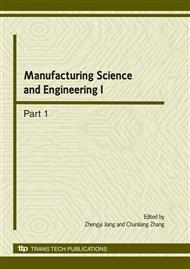p.4282
p.4287
p.4293
p.4297
p.4301
p.4305
p.4309
p.4313
p.4319
In Service Detection of 45 Steel’s Rotary Bending Fatigue Damage Based on Metal Magnetic Memory Technique
Abstract:
In order to study the relation between metal fatigue damage and the associated magnetic memory signals, the detection theory was studied based on magneto mechanical effect, and the rotating bending fatigue experiments on 45 steel were carried out combined with on-line data collecting system. The magnetic signals along axis at prefab defects in the fatigue process were studied. Experimental results show that the characteristics of the magnetic signals are different at every different stage of the fatigue process, in particular the magnetic signal changing faster in the late fatigue process, which indicates that it is feasible to detect fatigue damage using metal magnetic memory technique. Accordingly, the method is proposed to detect the rotation-bending fatigue damage for specimens in service by magnetic signals.
Info:
Periodical:
Pages:
4301-4304
Citation:
Online since:
March 2010
Authors:
Price:
Сopyright:
© 2010 Trans Tech Publications Ltd. All Rights Reserved
Share:
Citation:


